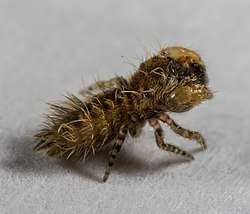Uroballus
Uroballus is a spider genus of the jumping spider family, Salticidae. It includes five or six accepted species.[1][2]
| Uroballus | |
|---|---|
 | |
| male Uroballus carlei from Hong Kong | |
| Scientific classification | |
| Kingdom: | |
| Phylum: | |
| Class: | |
| Order: | |
| Family: | |
| Subfamily: | |
| Tribe: | Viciriini |
| Subtribe: | Simaethina |
| Genus: | Uroballus Simon, 1902 |
| Type species | |
| Uroballus octovittatus Simon, 1902 | |
| Species | |
|
see text | |
| Diversity | |
| 6 species | |
Uroballus is similar to the related genus Stertinius.[3] Other related genera are Ligurra, Phyaces and Simaetha.[4]
Description
Uroballus are about 3 mm long in both sexes. The cephalothorax is very broad, almost square. The abdomen is oval, the first pair of legs thick and short with swollen femora. The other legs are weak.
The spinnerets are very long and thin.[5] Among spiders, only Hersiliidae possess longer spinnerets. The function of such long spinnerets remains unknown.[4] Adult spiders of some species may mimic lichen moths caterpillars.[2]
Name
The genus name is a combination of Ancient Greek οὐρᾱ́ (ourā́) "tail" and the salticid genus Ballus, referring to the long spinnerets.
Species
As of April 2019, the World Spider Catalog accepted five species:[1]
- Uroballus henicurus Simon, 1902 — Sri Lanka
- Uroballus kinabalu Logunov, 2018 — Borneo
- Uroballus koponeni Logunov, 2014 — Borneo
- Uroballus octovittatus Simon, 1902 — Sri Lanka
- Uroballus peckhami Zabka, 1985 — Vietnam
A further species was described in 2019:[2]
- Uroballus carlei Logunov & Obenauer, 2019 — Hong Kong
References
- "Gen. Uroballus Simon, 1902". World Spider Catalog. Retrieved 20 March 2019.
- Logunov, D.V. & Obenauer, S.M. 2019. A new species of Uroballus Simon, 1902 (Araneae: Salticidae) from Hong Kong, a jumping spider that appears to mimic lichen moth caterpillars. Israel Journal of Entomology 49(1): 1–9.
- Logunov, D. V. (2018). Description of two new species from the genera Stertinius Simon, 1890 and Uroballus Simon, 1902 (Aranei: Salticidae) from north Borneo. Arthropoda Selecta 27(1): 57-60
- Logunov, D. V. (2014). Description of a new species of Uroballus Simon, 1902 (Araneae: Salticidae) from Malaysia, with the longest spinnerets of any known jumping spider. Zootaxa 3894(1): 183-187
- Murphy & Murphy 2000: 289
Bibliography
- Murphy, Frances & Murphy, John (2000): An Introduction to the Spiders of South East Asia. Malaysian Nature Society, Kuala Lumpur.